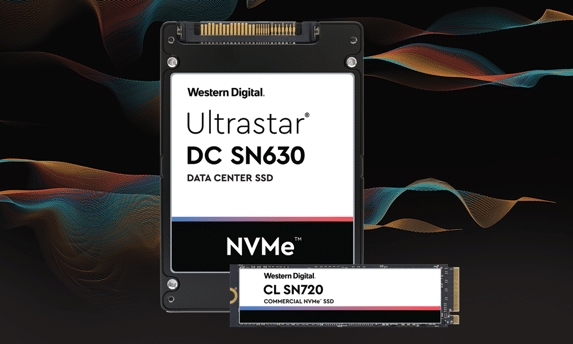Data is changing our lives. It can help us do everything from finding cures to disease with precision medicine to increasing the chances of our favorite football team winning on the field. Driving these capabilities is an ever-expanding amount of data. This expanding data also needs to be processed in shorter and shorter time periods. Data centers are adopting new storage architectures to meet these dual goals of size and speed.
Data Architecture Changes from Core to Edge
These changes are not happening just inside core and cloud data centers. They’re happening out in the wider world, at the “edge.” Taking its cue from the way your body’s reflexes work, with neurons placed far from your brain to handle urgent situations quickly, the edge distributes processing outside of the traditional data center. By putting intelligence in a subway car deep underground, on a wireless gateway on the roof of a building, or deep in the wilderness monitoring energy transmission, actions can be taken quicker and the load on the central data center reduced.
Edge architectures have challenges quite different from traditional data centers: temperature ranges from arctic cold to Saharan hot, shock and vibrations from everything from potholes to air turbulence, and surviving hundreds of miles from the nearest repairman.
Today Western Digital announced the Ultrastar® DC SN630 and the Western Digital® CL SN720, two new NVMe products that help address these challenges in the data center and on the edge. These additions to our portfolio bring more choice, better cost efficiencies, and superior solutions for data architects.
The Adoption of NVMe
Just as the never-ending desire for storage speed caused SSDs to displace hard drives in performance applications, NVMe is displacing all other storage interfaces out there for performance critical applications.
NVMe is a mature and compatible interface standard, based on PCI Express, that allows SSDs to avoid the bottlenecks inherent in the legacy SATA protocol. Since it’s based on PCIe and requires no host controller, it can deliver much lower latencies and massively higher bandwidths than SATA in many applications.
NVMe – More Than One Flavor
One of the great benefits of NVMe is the variety that it can provide, with different physical form factors, performance levels, and power tuning, enabling the best TCO for a specific application. We’ve tuned these two NVMe devices for scale-out and edge workloads that care about power and overall cost while supporting diverse read-intensive (RI) and very read-intensive (VRI) workloads such as NoSQL and boot.

Ultrastar DC SN630 – Essential NVMe for the Data Center
The Ultrastar DC SN630 is an enterprise-class NVMe SSD available in capacities from 800GB to 7.68TB[1], in the industry standard U.2 form factor. It provides balanced power, performance, and price for cloud data centers and is optimized for applications such as:
- Hyperconverged Infrastructure (HCI)
- Software Defined Storage (SDS)
- NoSQL scale-out databases
- Content streaming
With up to 2.7 GiB/s sequential read bandwidth and an NVMe 1.3 compatible interface, it provides a path for customers looking to move their aging SATA infrastructure into a modern, scalable storage architecture.
Western Digital CL SN720 – NVMe for the Edge in Challenging Environments

The Western Digital CL SN720 is a purpose-built NVMe SSD M.2 2280 form factor for the workload requirements of read-intensive edge deployments, e.g., content delivery, cloud gaming, IoT, and analytics. Capacity points range 256GB to 2TB. Self Encrypting Drive (SED) support with TCG OPAL 2.01 and ATA password lock is provided for security.
This NVMe SSD is well-suited for edge deployments for its modest power requirements, operating temperature thresholds, 5-year limited warranty, reliable sustained read throughput, small form factor, i.e., 22mm x 80mm, vibration rating, and encryption support.
NVMe Innovation – Western Digital’s Ongoing Technology Leadership
Both the Ultrastar DC SN630 and the Western Digital CL SN720 are built and designed in-house and leverage our unique vertical innovation capability – optimizing technology at every level from NAND design to SSD production. Both drives contain our own BiCS3 3D NAND flash, whose 64 layers and TLC bit storage allow us to provide massive amounts of storage in small form factors, while keeping costs down.
The controllers, basically the intelligent CPU and special-purpose hardware that converts a pile of flash into an enterprise SSD, were also designed here at Western Digital. By going the extra mile to build a customized controller from scratch, instead of buying a general purpose one like many other less capable vendors, we can tune it specifically for our own flash and product needs. This flexibility lets us deliver SSDs with better power and performance than otherwise possible.
Availability
The Ultrastar DC SN630 is sampling at select customers today.
The Western Digital CL SN720 is available through authorized channel distributors today.
NVMe Innovation Prowess
We’re proud of our two newest NVMe SSDs and the capabilities they provide for data centers looking to migrate from aging SATA infrastructures and for the new edge applications they are enabling. For more information about Western Digital’s NVMe portfolio, product datasheets, and general enterprise NVMe information, click here.
Additional resources:
[1] One gigabyte (GB) is equal to 1,000MB (one billion bytes) and one terabyte (TB) is equal to 1,000GB (one trillion bytes) when referring to solid-state storage capacity. Accessible capacity will vary due to operating environment.
